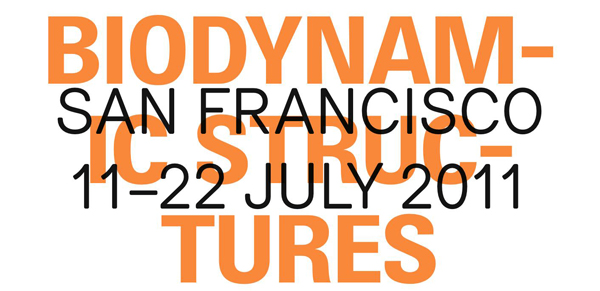Biodynamic Structures Workshop 2011
SAN FRANCISCO, CA | GRASSHOPPER & FIREFLY | JUL 11TH-22ND, 2011
Hosted by the California College of the Arts & the Architectural Association
Sponsored By McNeel Associates
I am excited to be an invited tutor for this year's Biodynamic Structures Workshop in San Francisco, CA. Biodynamics is the study of the force and energy of dynamic processes on living organisms. Through simple mechanisms embedded within the material logic of natural systems, specific stimuli can activate a particular response. This response occurs in carnivorous plants such as the Venus fly-trap, which uses turgor pressure to trap small insects in order to feed, and worms, which by contracting differently oriented muscles, achieve movement. This ten-day intensive workshop, co-taught by the faculty of the Emergent Technologies and Design Programme at the AA and the faculty of Architecture and MEDIAlab at California College of the Arts, will explore active systems in nature, investigating biomimetic principles in order to analyze, design and fabricate prototypes that respond to electronic and environmental stimuli.
Students will work in teams to research specific biological systems, extracting logics of organization, geometry, structure and mathematics. Advanced analysis, simulation, modeling and fabrication tools will be introduced in order to apply this information to the design of both passive and active responsive architectural systems. Investigation and application of robotics, sensors and actuators will be employed for the activation of the material system investigation through the construction of working responsive prototypes.
Click here to find out more details regarding registration or here to see images from last year's event.
Smart Geometry - Follow Up
We're just a week removed from the Smart Geometry conference held in Copenhagen, and now that the dust has settled I wanted to post a follow up to show some of the amazing work that was accomplished in just 4 short days. Our cluster group was quite inspiring and I had a great time meeting/working with all of them. Below is a brief video recap of the four day workshop (put together by Daniel Piker and Robert Cervellione). Find our more about our cluster at the Smart Geometry website. Enjoy.
Smart Geometry - Use the Force

I am proud to announce that I will be participating in this year’s SmartGeometry conference in Copenhagen, Denmark. I would like to thank Daniel Piker and Robert Cervellione for their invitation to be an assistant cluster champion for the 4 day workshop cluster titled ‘Use the Force’. I'd also like to express my sincere appreciation to Robert McNeel and Associates for their sponsorship for this event.
This cluster will explore the use of Kangaroo as a form-finding tool, and linking it to real-time sensor input (through Firefly). I think this is a unique and very exciting opportunity to come together to develop, test and really push the boundaries of what is possible with these design tools. Here's a little more information about the cluster:
Through Kangaroo, the live physics plug-in for Generative Components and Grasshopper, this cluster will explore ways of using the simulated interaction of physical forces and real-time spatial inputs to develop novel form-finding processes. The physics engine will constantly react to the streaming data - when one element in the system changes, the entire system adjusts itself accordingly in order to find and maintain equilibrium. Treating geometric and construction constraints, material behaviour, and user interaction all within this common language of physical forces unifies and allows complex real-time interaction between them.
The deadline for applications to the workshops has been extended until this Sunday, February 6th. Read more about it and apply here.
coLab | Hybrid Prototypes Workshop

I am very excited to announce that I will be working with Studio Mode in their next coLab workshop series: Hybrid Prototypes. Hybrid Prototypes is a two-day intensive design and prototyping workshop (with an optional third day) to be held in New York City during the weekend of January 08.
Description:
As architects and designers, we make things and build objects that interact with other objects, people, and networks. We strive for faster and simpler methods to build prototypes in the cheapest possible way, yet we are frequently hindered by temporal and practical factors that arise in the process of bringing our ideas to life. Firefly is the new paradigm for hybrid prototyping, offering a comprehensive set of software tools dedicated to bridging the gap between Grasshopper (a free plug-in for Rhino) and the Arduino micro-controller. It allows near real-time data flow between the digital and physical worlds – enabling the possibility to explore virtual and physical prototypes with unprecedented fluidity.
This fast-paced workshop will focus on hardware and software prototyping techniques. Using remote sensors, microcontrollers (Arduino), and actuators, we will build virtual and physical prototypes that can communicate with humans and the world around them. Through a series of focused exercises and design tasks, each attendee will make prototypes that are configurable, sensate, and active. An optional third workshop day is offered to those participants desiring further time to develop individual projects or lines of research. As part of a larger online infrastructure, modeLab, this workshop provides participants with continued support and knowledge to draw upon for future learning.
Attendance will be limited to provide each participant maximum dedicated time with instructors. Participants are encouraged to be familiar with the basic concepts of parametric design and interfaces of Grasshopper and Arduino.
Hybrid Prototypes was conceived through a collaboration between Studio Mode/modeLab and Andrew Payne/LIFT Architects/Grasshopper Primer/ Firefly.
Instructors:
Andrew Payne | Principal, LIFT Architects | Co-Author, Grasshopper Primer | Co-Author, Firefly.
Ronnie Parsons + Gil Akos | Partners, Studio Mode.
Details:
All experience levels are welcome. Participants are encouraged to be familiar with the basic concepts of parametric design and interfaces of Grasshopper and Arduino.
Registration Pricing (limited enrollment) : $550/$650.
Workshop Location : modeLab | NYC.
Workshop Hours : 10AM-6PM.
Examples of Previous Workshops.
Infrastructure:
coLab Workbook | Printed + PDF Documentation
coLab Primers | Annotated Primer GHX Files
coLab Exercises | Annotated Exercise GHX Files
modeLab Fabrication Equipment | CNC High Force Cutter
Topics:
Arduino Micro-controller Hardware
Arduino Control Logic
Firefly Components
Parametric Design Logics
Basic Circuitry
Sensors + Actuators
Dates:
2010.December.03 | Workshop Announced + Registration Opens.
2011.January.08 | Workshop Begins.
2011.January.10 | Optional Workshop Session.
To register for the workshop, please follow this link.
The Grasshopper Primer - Korean Edition

I would like to extend a huge congratulations to Kichan U and his team of translators for taking on the monumental task of translating the entire 160 pages of the Grasshopper Primer (second edition) into the Korean language. A lot of hard work went into this translation and it is our hope that this work will help spread information about the Grasshopper plugin to Korea and beyond. Kichan U and his team (including Ms. Jaewon Shin) at RP Architecture Engineering & Consulting have started an online community to get feedback from Korean Grasshopper users. Feel free to visit: http://cafe.naver.com/mustbim to join in the discussion.
Source Files:
The Grasshopper Primer_Korean Edition.pdf (size: 5.6mb - right-click and select 'Save Link As' - Adobe Acrobat needed)
Primer Source Files (size: 193k - right-click and select 'Save Link As' - this is a collection of Grasshopper definitions and Rhino files needed to complete the examples in the primer)
Surface Patterns With The ShopBot Writer for Grasshopper
It has been entirely too long since I last posted but that should change over the coming weeks as I've been working on some really amazing projects. To kick things off, I thought I'd share a one week project that I developed to create a dimple halftone pattern on a surface using a custom build Grasshopper definition which writes the all of the G-code (for a ShopBot CNC mill) in real-time. I'll talk more about the fabrication setup below, but first... a little about the concept. I've always been fascinated with the skeletal patterns of Radiolarians (a family of microscopic protozoa that float along the ocean floor). Here's a Wikipedia link for more information. These creatures (perhaps "fossil" is a better word) were made popular by some amazingly detailed and beautiful drawings made by German biologist Ernst Haekel.
I decided to take something very big (the final piece is milled out of a half size sheet (72"x30") of Corian) out of something that is very very small. To get the desired relief pattern, I used a 3/4" V-bit endmill on the CNC mill so that the circle diameter had a linear relationship to the depth of the plunge. Below are some process images showing the original source image and the step needed to take it into final fabrication using the ShopBot Writer definition I developed for this project.
Before I get to far, there are a few precedent projects that I would like to acknowledge. The 'dimple halftone' pattern idea was a concept developed by Associated Fabrication and 4-pli and was published in Transmaterial 2. MachineHistories has also made a series of beautiful panels that can be seen here. The concept for the work below is inspired by these precedent projects, but the method through which it was employed is new and documented below.
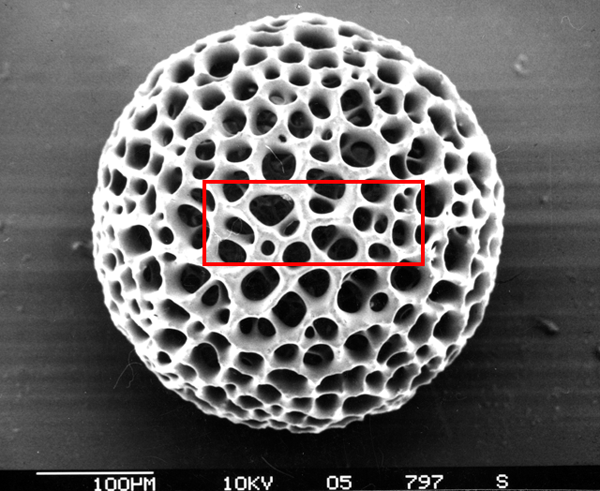
Cropped and Zoomed-In on Image
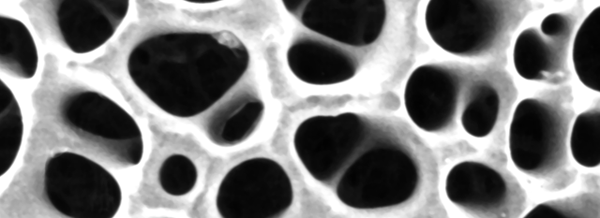
Gaussian Blur and Highlight Sampling (blur added to reduce noise in original image)
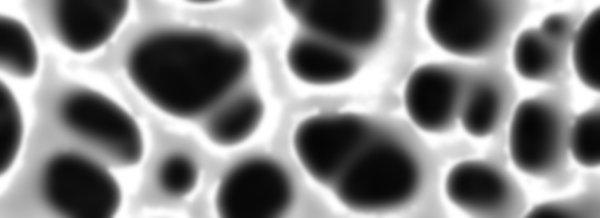
Grasshopper Approximation of Milling Pattern (automatically generates Shop Bot g-code in real-time)
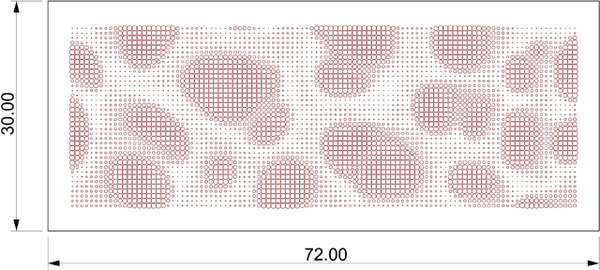
CAD/CAM Preview of Tool Path from Shop Bot Controller (simulation of final cut)
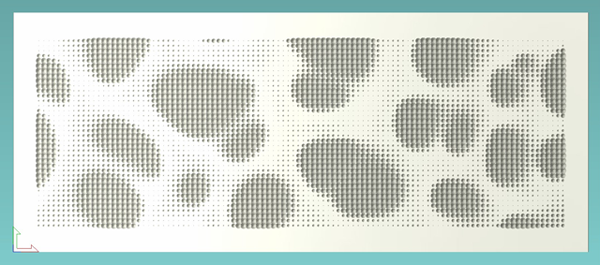
The Final Installed Piece (72"x30"x1/2")
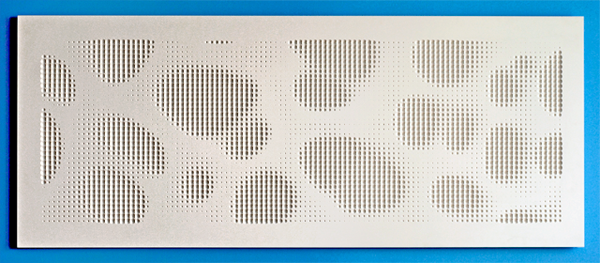
The image becomes more pronounced on the oblique.
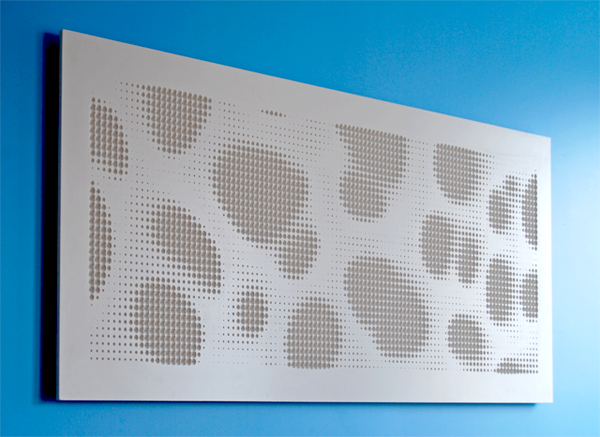
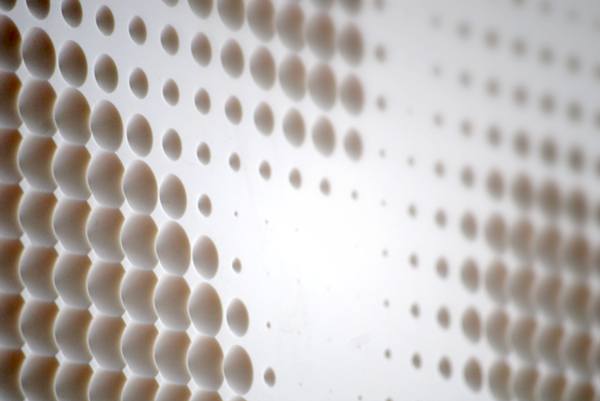
The parametric process for this project was relatively straight forward. There have been many examples of patterns generated using the Image Sampler component, and this one is pretty similar to those, so I won’t go into great detail about how that part is set up. The Shop Bot Part file format (.sbp) is essentially just a text file with commands about how the machine should behave. The trickiest part on this entire project was learning the exact command prefixes that are needed to drive the machine. Since these are proprietary (for the Shop Bot), the commands are slightly different than traditional g-code. I found two helpful manuals on the Shop Bot website.
- Command Reference V3 - How to use individual commands in the Control Software
- Programming Handbook - How to program part files
With these two manuals as my guide, it was quite easy to setup the entire tool path part file. I found that the Weave component became very handy when joining together the movements needed for the plunges. I did have to write a little custom code to deal with the header file. This header works for this specific application (using a V-bit 0.75" dia.) but might need some minor modifications if the method of milling were to change (such as surface milling, or profile cutting as opposed to direct plunging). Below are a few screen captures of the Grasshopper definitions.
The file is meant to be used for academic, and other non-profit institutions for non-commercial, non-profit internal research purposes. This file was created (and tested) in Grasshopper version (0.7.0055). Results may vary if using a different version.
- Grasshopper Shop Bot Writer (369kb - right click and 'Save Link As')
Disclaimer: This file is provided by Andrew Payne | Lift Architects and is furnished "as is". Any express or implied warranties, including, but not limited to, the implied warranties of merchantability and fitness for a particular purpose are disclaimed. In no event shall Andrew Payne be liable for any direct, indirect, incidental, special, exemplary, or consequential damages (including, but not limited to, procurement of substitute goods or services; loss of use, data, or profits; or business interruption) however caused and on any theory of liability, whether in contract, strict liability, or tort (including negligence or otherwise) arising in any way out of the use of this file, even if advised of the possibility of such damage.
New Firefly Website, Tools, Examples, and Primer

Jason K. Johnson and I are very excited to unveil the new home for all things Firefly! Come find out the latest features, tutorials, photos, videos and much more at http://www.fireflyexperiments.com. We are encouraged by the growing community of Firefly users and this website will be the destination for those individuals looking to bridge the gap between Grasshopper (a free plug-in for Rhino), the Arduino micro-controller, the internet, and beyond. Come take a look and let us know what you think!
In addition to the public launch of our new website, we have also released a new Firefly Toolbar (version 1.003) and an updated Firefly Primer. We have fixed a few minor bugs and added a few new features that were requested by you - the users. A delay feature has been added to both Fader (one way and two way) components and the Data Log component has been completely re-written to enable greater flexibility. Users can now simulate "Live Looping" techniques by using the Wrap feature on the Data Log component which also allows for direct data streaming to a file path of your choosing (.txt, .csv, or .dat). Additionally, we have built a new Playback component which will return individual lines from a text file at a given frame rate(s). The ability to control multiple frame rates will allow you to create some really amazing effects.
If that wasn't enough, there is a new Firefly Primer (a 37 page manual) which provides an in-depth look at each individual component and walks you through the entire process of using this powerful new tool-set (from installation to final output). It also includes some basic tutorials, links and references to get you up and running quickly.
Come join the Firefly community and find out what everyone is talking about. Visit http://www.fireflyexperiments.com. If you have suggestions or if you just have a question, feel free to email us at info@fireflyexperiments.com.
Repeat Competition (Deadline Extended)

Architecture is defined by connections: the method and the material by which an assembly is developed to create enclosure. This process results in an active, performative connection, one that is specific and definitive and produces an architecture that can be built through iterative means. REPEAT asks that you look first to the connection and through repetition to define the whole. In brief, by reevaluating the design process and looking at it from the connection, what emerges?
REPEAT as an international competition is established to foster the creative spirit in the burgeoning field of digital fabrication. We encourage the generation of cutting edge design proposals for a structure of your design with the only caveats being it be generated and conceived digitally, incorporate repetitive elements, be optimized for relocation and transportation and be produced through fabrication technologies available within Houston, Texas.
Within cities with atomized light manufacturing capabilities like Houston, there exists a potential for designers to engage fabrication via direct communication with machines. A culture of making that has its foot in the energy and aerospace industries is ready to be appropriated and applied to architecture. The competition challenges the current exploration of parametric design to engage this latent field of production to explore a meaningful synthesis based on repetition and variation.
The evaluation of all the REPEAT proposals will focus on the cohesion of the design concept to digital fabrication techniques and methods of assembly. Factoring in these two foundational requirements for the competition, the entrant is encouraged to propose a solution that is both formally challenging in the mechanics and aesthetics of the connections, but also speak to the issues of use and performance.
Jury: Patrik Schumacher, Marc Fornes, Lisa Iwamoto, Chris Lasch and Blair Satterfield
| JUNE 16, 2010 AUGUST 16, 2010 OCTOBER 3, 2010 OCTOBER 24, 2010 NOVEMBER, 2010 – FEBRUARY, 2011 |
Online Registration and Competition Regulations Available to the Public Questions Due to TEX-FAB via Email Online Submission of Entries (Due Midnight) 12:00 AM CST Jury Awards Made Public Winning Design is developed, fabricated and installed in Houston |
Biodynamic Structures Update
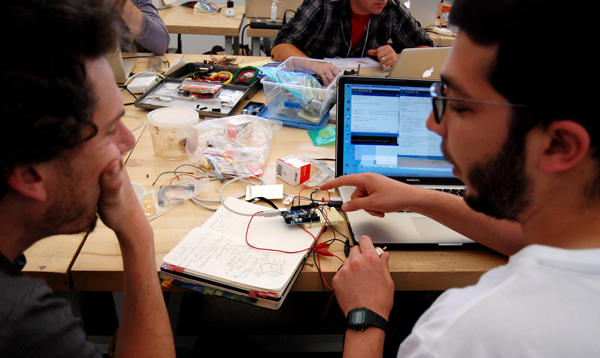
The Biodynamic Structures workshop (hosted by the AA and CCA) is well underway and it has been amazing to see the intensity by both the instructors and the students. I will be posting more information about the final exhibition for this event which will be happening next Wed (July 22nd), but definitely make sure you take a look at the Flickr site which is updated daily with new photos from the event. The flickr site can be found here.
Material Resonance Workshop

ST. LOUIS, MO | RHINOSCRIPT, GRASSHOPPER, & FABRICATION | AUG 9TH-12TH, 2010
Hosted by Washington University in St. Louis Sam Fox School of Art and Design
Sponsored By McNeel Rhinoceros
Material Resonance will be a four day, intensive workshop focused on practical application of Rhinoscripting or Grasshopper. The workshop will also train participants in CNC fabrication using MasterCAM and the Washington University DIL fabrication lab. There will also be demos of the new plug-ins Firefly and Kangaroo.
The workshop is meant for professionals or students with a working knowledge in Rhinoceros. Prior experience with Grasshopper or Rhino VB scripting is not necessary. The workshop will start from first principles and cover topics from tessellation, components and connections to part organization, nesting and labeling.
Instructors
Marc Fornes _ theverymany Rhino VB scripting
Andy Payne _ LIFT Architects Grasshopper
Kenneth Tracy _ Associated Fabrication MasterCAM
For more information and to register go to:
http://samfoxschool.wustl.edu/events/workshops/3630
Biodynamic Structures Workshop

I am excited to announce that I will be working as an Associated Faculty member at the Biodynamics Structures workshop being hosted by the Architectural Association and the California College of the Arts from July 12th-21st, 2010. Both institutions have assembled a truly first class set of instructors and it promises to be a ground breaking event. I would like to thank Andrew Kudless and Jason Kelly Johnson for this invitation. See workshop details below.
BIODYNAMIC STRUCTURES
AA Visiting School @ CCA California College of the Art
Monday 12 to Wednesday 21 July, 2010
Biodynamics is the study of the force and energy of dynamic processes on living organisms. Through simple mechanisms embedded within the material logic of natural systems, specific stimuli can activate a particular response. This response occurs in carnivorous plants such as the Venus fly-trap, which uses turgor pressure to trap small insects in order to feed, and worms, which by contracting differently oriented muscles, achieve movement. This ten-day intensive workshop, co-taught by the faculty of the Emergent Technologies and Design Programme at the AA and the faculty of Architecture and MEDIAlab at California College of the Arts, will explore active systems in nature, investigating biomimetic principles in order to analyze, design and fabricate prototypes that respond to electronic and environmental stimuli. Students will work in teams to research specific biological systems, extracting logics of organization, geometry, structure and mathematics. Advanced analysis, simulation, modeling and fabrication tools will be introduced in order to apply this information to the design of both passive and active responsive architectural systems. Investigation and application of robotics, sensors and actuators will be employed for the activation of the material system investigation through the construction of working responsive prototypes.
+ CONTENT TAGS: Biodynamic, Parametric, Scripted, Mimetic, Responsive, Interactive, Digitally Fabricated
+ SOFTWARE: Rhino, Grasshopper, Firefly, RhinoScript, Arduino, Processing
CORE FACULTY
Michael Weinstock (Academic Head, Director of Emergent Technologies Programme, AA London UK)
Christina Doumpioti, Evan Greenberg, Konstantinos Karatzas (Tutors, AA EmTech Programme, London UK)
Jason Kelly Johnson [Future Cities Lab], Andrew Kudless [Matsys] (CCA MediaLab Coordinators, SF CA)
ASSOCIATED FACULTY
George Jeronimidis (Director of Center for Biomimetics, University of Reading UK); Andrew Payne (LIFT Architects, Grasshopper Primer); Daniel Segraves (ASGG Adrian Smith + Gordon Gill Architecture); Ronnie Parsons + Gil Akos (Studio Mode, NY); Daniel Piker (Kangaroo Project Live Physics)
ENROLLMENT INFORMATION
http://sanfrancisco.aaschool.ac.uk; or visit the CCA MEDIAlab website: http://mlab.cca.edu
(Workshops are non-credit. Enrollment is processed by the AA. Workshop will run the full 10 days.)
CONTACT
visitingschool@aaschool.ac.uk or mlab@cca.edu
Formations 2010

SAN FRANCISCO, CA | PARAMETRIC URBANISM WITH GRASSHOPPER | FEB 13-14, 2010 | 10:00am-5:00pm
I am really excited to be participating in the upcoming Formations 2010 workshop series being held at the California College of the Arts campus in San Francisco. There is a really great lineup of instructors teaching a wide array of topics:
- Mapping Urban Information with ESRI ArcGIS by Mona El-Khafif (CCA URBANlab) and Richard Kos (CCSF GIS Education Center/ San Jose State University)
- Neocartography - an Introduction to Interactive Mapping with Flash by Sha Hwang (Stamen Design)
- Parametric Urbanism with Grasshopper by Andy Payne (Lift Architects) and Andrew Kudless (Matsys/CCA MEDIAlab)
- Sensing the City with Arduino and Processing by Jason Kelly Johnson (Future Cities Lab/CCA MEDIAlab) and TBA instructor
- Parametric Design Modeling with Revit by David Fano (Case, inc./ DesignReForm.net/Columbia GSAPP)
- ECOlogics with Ecotect by Nataly Gattegno (Future Cities Lab / CCA ECOlab) and Olivier Pennetier (Symphysis)
Below is a synopsis of the Parametric Urbanism workshop I will co-teaching with Andrew Kudless.
Instructor: Andy Payne (Lift Architects) and Andrew Kudless (Matsys/CCA MEDIAlab)
This workshop will focus on the generative modeling of urban design logics using the Grasshopper plugin for Rhino 4.0. From the early work of firms such as MVRDV to the more recent investigations by Zaha Hadid, a parametric approach to urban design has allowed designers to condense complex hierarchies of design data into solutions that exhibit highly differentiated patterns of urban form. The workshop will cover several techniques that attempt to integrate common urban design parameters dealing with massing, program, and density into one associative model allowing the designer to quickly and accurately test multiple design scenarios. The first day of the workshop will introduce many of the central topics and techniques of parametric urbanism while the second day will focus on the implementation of these techniques in a large, complex urban masterplan.
Eligibility: Open to all design students and professionals.
Cost: $100 for students, $200 for professionals.
Click here to register for this event.
![[LIFT] architects](/storage/layout/Header_025.png)
